How To Get Import License In Australia?
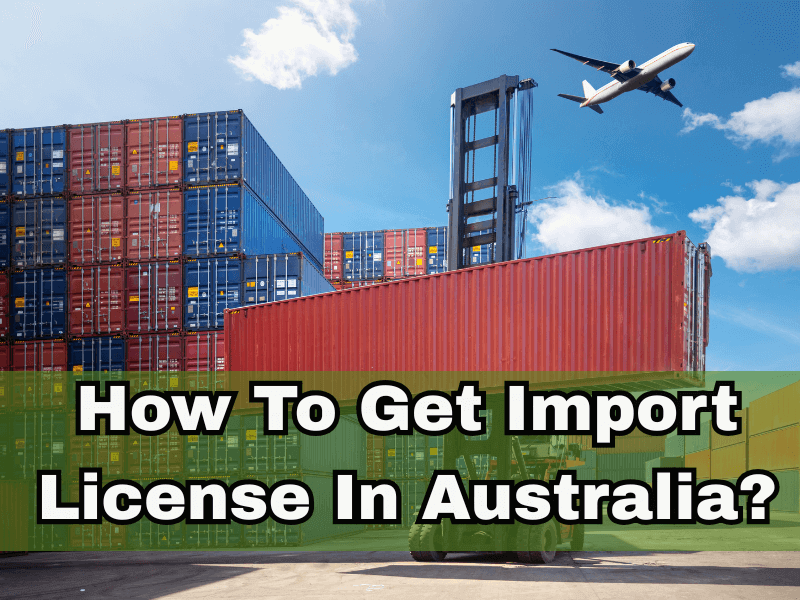
Understanding how to get an import licence in Australia can feel confusing, especially if you’re new to international trade.
Don’t worry. We will explain the steps in a clear and easy way so you can start importing with confidence. Whether you’re just starting or growing your business, this guide will make it simple. Let’s get started!
What is an Import License in Australia?
Individuals or businesses looking to import goods into Australia are generally not required to possess an import license. Regardless, certain classes of goods may require an import permit, which must be obtained prior to shipment clearance at customs.
More sensitive items such as medicines, plants, animals, food, and weapons typically require permits for import.
For instance, the importation of some pharmaceutical drugs or biological materials requires a permit, while some items such as certain protected plant species must fulfil very specific conditions set by Australian law.
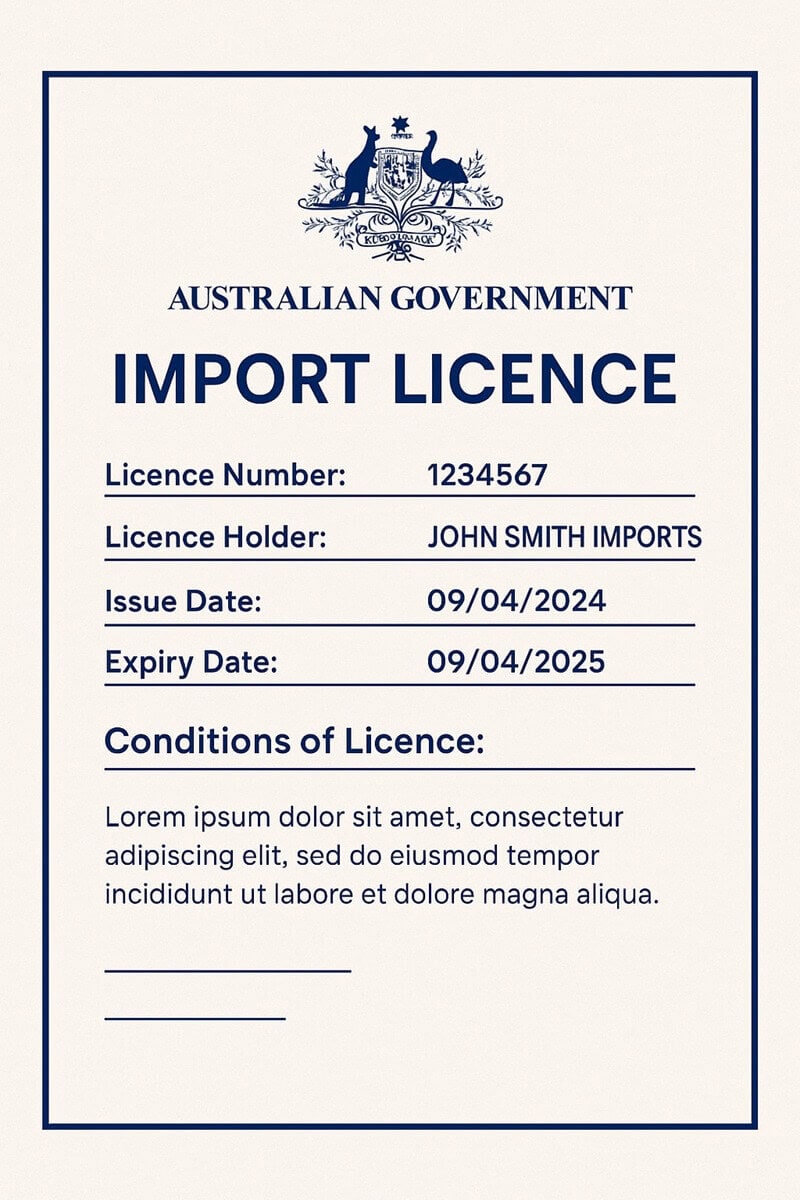
The permits are issued through the BICON system, which aids businesses in determining whether a specified good requires a permit as well as provides the opportunity to apply for a permit.
Certain regulatory changes, such as more stringent biosecurity protections for some plant seeds, demonstrate Australia’s commitment to safeguarding the environment and agriculture.
As a best practice, checking the BICON system or seeking professional advice from a customs broker is advisable. Following these guidelines ensures compliance with international import laws and, more importantly, avoids delays.
Do You Need an Import License in Australia?
Australia does not need a general import license for individuals or businesses wanting to bring goods into the country. Nevertheless, some goods do require specific import permits before clearing customs.
These permits ensure compliance with Australia’s strict biosecurity laws that guard its environment, economy, and populace.
Here’s a list of common goods that often require permits for importation into Australia:
| Goods | Examples | Reason for Permit |
|---|---|---|
| Medicines and Drugs | Pharmaceutical products, steroids, and prescription drugs | To ensure safety and compliance with health laws |
| Plants and Seeds | Protected plant species, seeds for sowing | To prevent the introduction of harmful pests |
| Animals and Animal Products | Pets, livestock, meat, dairy, or wool products | To maintain biosecurity and animal health |
| Weapons and Firearms | Guns, ammunition, and other related items | To comply with safety and legal regulations |
| Food Items | Processed foods, fresh produce, seafood | To meet food safety and quarantine standards |
| Cultural or Heritage Items | Artifacts, antiques, or items with cultural significance | To protect heritage laws |
Permits for these listed items are often processed through the BICON system. This site provides information on what goods permits are required and provides aid through application completion.
If you need expert opinion then you can contact one of these top freight forwarders in Australia
Step-by-Step Guide to Importing into Australia
Before you import goods into Australia, it’s crucial to check if they need a specific permit.
Step 1: Determine If Your Goods Require a Permit
The easiest method to find out if your goods need a permit is using the Biosecurity Import Condition (BICON).
BICON, short for Biosecurity Import Condition, is an online platform that helps you identify the best imported condition for your goods while offering blatant information about Australian import requirements. Steps include:
1)Visit the BICON website.
2)Use the search feature and submit your query, be it ‘seeds’ or ‘human drugs.”
3)Permits that are applicable to you will be displayed, along with some additional instructions concerning the goods.
4)If necessary, follow the instructions to apply for a permit directly through the platform.
For new importers, they also have a step-by-step guide.
Prohibited and Restricted Goods
Australian government has two types of restrictions on specific goods. The types are
- Restricted Goods: Items that need special permits or approval to import.
- Prohibited Goods: Items completely you CAN NOT import anyway.
What Items Are Banned or Restricted and Why?
Below is a list of common examples and the reasons behind these restrictions:
| Category | Examples | Reason |
|---|---|---|
| Weapons and Firearms | Guns, ammunition, pepper spray | National safety and legal compliance |
| Plants and Seeds | Protected species, invasive plant varieties | To prevent pests and diseases |
| Animals and Animal Products | Live birds, exotic pets, untreated animal hides | Biosecurity and native species protection |
| Medicines | Steroids, unapproved drugs, controlled substances | Ensuring safe and lawful medical use |
| Cultural Artifacts | Items of cultural significance, historical artifacts | Preservation of global and national heritage |
| Food Products | Fresh fruits, raw meat, unapproved dairy products | Biosecurity and public health protection |
For the full list of prohibited or restricted items, visit the Australian Border Force Prohibited Goods page.
Step 2: Register Your Business for Importing
You will need to register with the relevant authorities if you aim to import goods into Australia. Registration enables the business to appropriately comply with tax systems, make use of duty reductions, and generally ease the import procedure.
Getting an Australian Business Number (ABN)
An Australian Business Number (ABN) is important for any firm that intends to engage in importing. It looks up your business with the government and enables you to:
- Register for GST (Goods and Services Tax)
- Claim GST credits
- Use the GST deferral scheme for import taxes
To apply for an ABN, visit the Australian Business Register website. The application has no charging fee. Usually, approval is quite fast as long as all details are correct.
Registering with Relevant Authorities
Depending on what you plan to import, you may also need to register with specific bodies. For example:
- Customs Brokers and Experts: If your goods require technical surveys or permits.
- Department of Agriculture, Fisheries and Forestry: For goods like food, plants, or animals that must meet biosecurity regulations.
- Therapeutic Goods Administration (TGA): For importing medicines or medical devices.
Pro Tip: Each authority has its own requirements, so check their websites for detailed guidance.
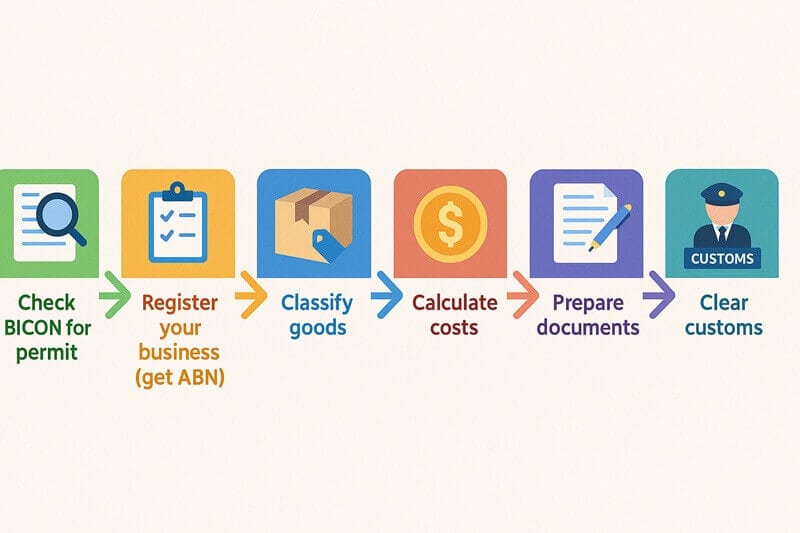
Step 3: Classify Your Goods Correctly
Importance of Accurate Classification Under the Customs Tariff Act
Under Australia’s Customs Tariff Act 1995, every good imported into the country is supposed to have a certain tariff classification.
This classification is the one that determines the duty rate as well as customs understanding what is being brought in. It is also important to be correct in classification because:
- Limits the risk of non-compliance with Australian legal frameworks.
- It streamlines the process of estimating taxes and tariffs.
- It reduces the chances of custom clearance delays.
You can find the tariff classification for your goods by using the Australian Customs Tariff system. Besides, you can take help from a customs broker.
Penalties for Incorrect Classifications
Submitting the wrong classification can lead to:
- Delays in clearance
- Financial penalties
- Goods being held or confiscated
For instance, if you misclassify a restricted item, customs could impose significant fines. Therefore, always double-check classifications. If you are not sure, ask for professional help.
Step 4: Calculate Costs and Duties
Breakdown of Import Costs
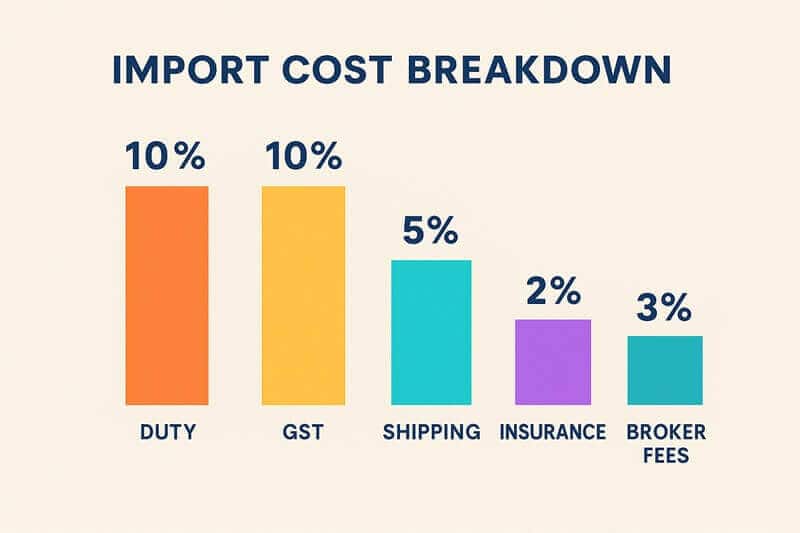
When you import goods, you also need to pay extra costs along with the price of the item. Here is a more elaborate list of what needs to be noted:
- Customs set duty: based on the tariff classification and the value of the item.
- Services and Goods Tax (GST): Usually 10% of the goods and additional charges such as shipping and insurance.
- Shipping and Freight Charges: These are determined by the carrier, distance, and volume of the shipment.
- Protection: Needed to ensure the integrity of the items while in transit.
- Broker fees: Paid by custom clearance brokers for their services.
For instance, importing A$10,000 worth of machinery may entail paying a duty of 5% and GST of 10%, along with extra shipping and insurance costs, resulting in substantial expenditures alongside the product price.
For more details: How much is the Import Customs and Duties from China to Australia?
Duty Concessions and Free Trade Agreements
Australia, for example, has several FTAs, which are free trade agreements with Japan, the US, and China that reduce or eliminate import duties on certain goods of Australia. There are specific rules of origin stipulations that your goods must comply with in order to benefit.
In addition, some tariff concessions are provided for goods not produced in Australia. These can significantly lower the cost of importing goods.
To check if your goods are eligible for concessions or FTAs, visit the Australian FTA information page.
Step 5: Engage a Customs Broker for Customs Clearance (Optional)
For first-time importers, dealing with customs for the first time may prove difficult. Using the assistance of a customs broker will make everything easier for you.
Why Use a Customs Broker?
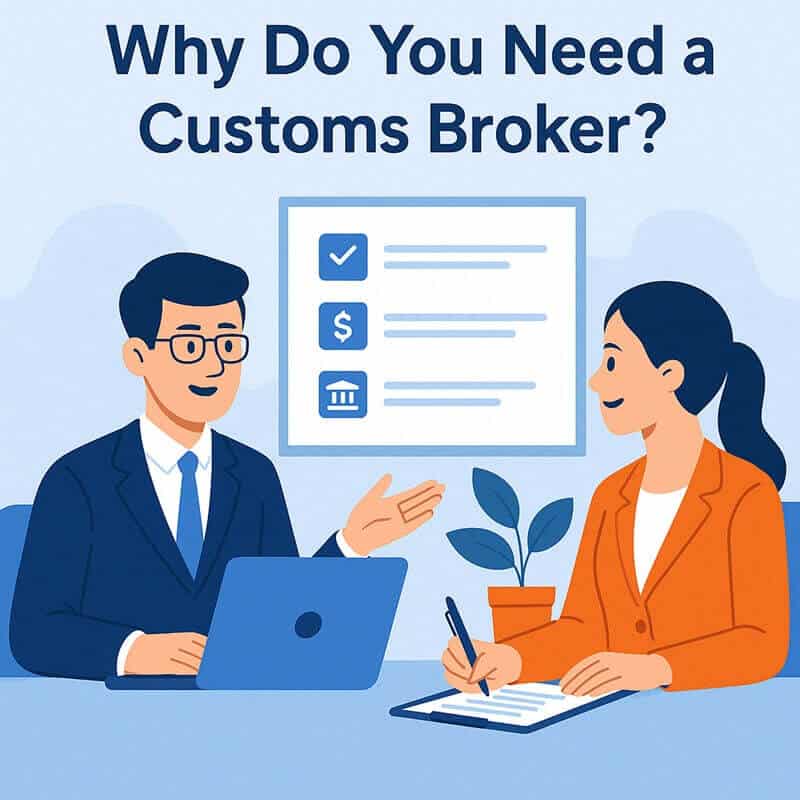
A customs broker offers several advantages, including:
- Knowledge Of The Industry: Brokers are familiar with the Australian customs legislations and mark the boxes of all compliances needed to be followed.
- Saving Time: They will prepare and optimize all the necessary documents and deal directly with customs.
- Correct Classification: Brokers will aid in the proper classification of the goods, which guarantees lower margins of being penalized.
- Saving Costs: With the right guidance, a customs broker will enable you to save money on extra duties, concessions, and other Free Trade Agreement benefits.
- Dealing With Problems: Brokers are in charge of unblocking the many customs hurdles that arise on the way, which is faster than normal procedures.
How to Find a Licensed Customs Broker
Finding the right customs broker is crucial for a smooth import experience. Here are some tips to help you choose:
- Check Compliance: Confirm the broker is licensed on the Department of Home Affairs website.
- Look for Experience: Choose brokers with a track record in handling similar imports.
- Read Reviews: Check online feedback or ask for client references.
- Book a Consultation: Many offer a free first meeting to assess needs and provide a quote.
- Compare Fees: Get quotes from multiple brokers to ensure competitive pricing.
Special Considerations for Importing
In Australia, the basic processes for importing goods also have particular nuances that must be taken into account, especially with biosecurity and labeling, and trade descriptions.
Biosecurity Requirements
To defend its environment and agricultural activities, Australia applies the strictest laws concerning biosecurity as a means of containing pests and diseases.
Under the Biosecurity Act 2015, all structural measures to biosecurity must be in place regarding goods entering the country. These measures cannot threaten the biosecurity of the country.
To check if your goods are subjected to biosecurity controls:
- Use the BICON system: The Biosecurity Import Conditions (BICON) database provides the functionality to check whether your goods have an import quota or other specifications such as treatment or the need to meet certain conditions. Non-compliance with biosecurity requirements might lead to scrutiny ranging from voluntary contravention of pending compliance, fines or delays, and demolition of assets and property.
Labelling and Trade Descriptions
In Australia, proper labeling goes hand in hand with the import of trade goods. The Commerce (Trade Descriptions) Act 1905, along with other affiliates, requires a section of the products to have accurate trade descriptions.
Key labeling requirements include:
- Language: All labels must be in English.
- Visibility: Labels should be in prominent and legible characters.
- Placement: Labels must be on a principal label or brand attached to the goods in a prominent position.
- Content: Labels must include the name of the country where the goods were made or produced.
For more detailed information on labelling requirements, refer to the Australian Border Force’s guidelines.Australian Border Force Website
Practical Tips for First-Time Importers
- Select goods that do not require special permits for your first import.
- The BICON system must be checked before every importation.
- Register for an AUS Business Number before other processes start.
- To evade penalties, use the appropriate Tariff Classification.
- Invoices, shipping documents, permits, and other relevant documents should be systematically stored.
- Assign the correct HS code to classify your goods accurately.
- If you are uncertain of the processes, consider the aid of a licensed Customs Broker.
- An Import Order should only be made when import costs are known and understood.
- Ensure compliance with Australian labeling trade regulations.
- Track your shipments to avoid delays at the border.
- Review updates from the Australian Border Force regularly.
Final Words
When you understand the processes involved, importing goods into Australia is not as difficult as it seems.
Each step is important, from checking permits to applying for an ABN. Keeping up to date with the latest changes, complying with set regulations, and ensuring all paperwork is done are essential to avoid delays and additional costs.
Looking for assistance regarding your first import? Winsky Freight can assist you. Send us a message, and we would love to help you.

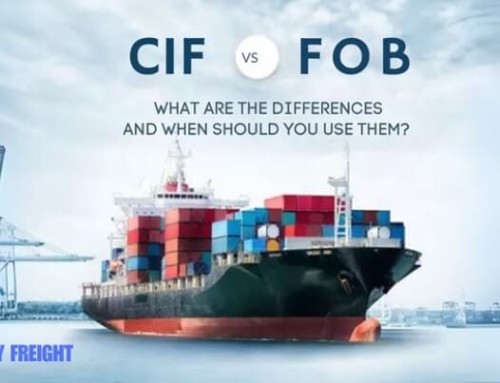

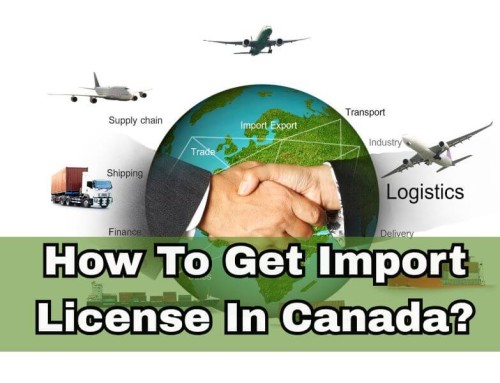

Leave A Comment